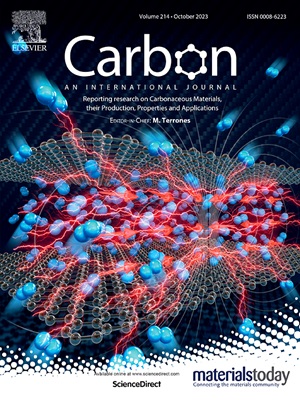Confined assembly of magnetic Fe3O4/carbon microspheres with enhanced wave absorption performance
IF 10.5
2区 材料科学
Q1 CHEMISTRY, PHYSICAL
引用次数: 0
Abstract
The escalating use of electronic devices in civil and military sectors has led to severe electromagnetic interference issues due to excessive electromagnetic radiation, impacting both equipment functionality and human well-being. Addressing this, electromagnetic wave absorption materials, particularly magnetic carbon superstructures, offer a dual loss mechanism suitable for microwave absorption, gaining much attention. In this work, through a polyelectrolyte-assisted assembly strategy, magnetic carbon superstructures (MCSSs) with high performance characteristics such as ultra-wide effective absorption bandwidth and minimal reflection loss have been developed. Detailed structural analyses through microscopy, XRD, elemental analysis, and magnetic studies confirm the successful synthesis of MCSSs with hierarchically porous structures, high specific surface areas of 476.6 m2 g−1, total pore volume of 0.27 cm3 g−1, and notable ferromagnetic properties. Each independently existing spherical MCSSs can be viewed as a separate confined space, in which well-dispersed homogeneous magnetic particles exist, which greatly improves the undesirable condition of local impedance matching imbalance caused by agglomeration of magnetic components due to intrinsic magnetic properties. Finally, the MCSSs hold excellent microwave absorption of −62.23 dB and radar cross section attenuation of 16.80 dB m2. These findings underscore the potential of magnetic carbon superstructures in advancing electromagnetic wave absorption technologies and highlight the importance of tailored design for optimizing material properties.
具有增强波吸收性能的磁性Fe3O4/碳微球的密闭组装
电子设备在民用和军事领域的不断升级使用导致了严重的电磁干扰问题,由于过度的电磁辐射,影响了设备的功能和人类的福祉。针对这一问题,电磁波吸收材料,特别是磁性碳超结构,提供了一种适合微波吸收的双损耗机制,引起了人们的广泛关注。在这项工作中,通过聚电解质辅助组装策略,开发了具有超宽有效吸收带宽和最小反射损耗等高性能特征的磁性碳超结构(MCSSs)。通过显微镜、XRD、元素分析和磁性研究等详细的结构分析证实,成功合成的mcss具有分层多孔结构,具有476.6 m2 g−1的高比表面积,0.27 cm3 g−1的总孔体积和显著的铁磁性。每个独立存在的球形mcss都可以看作是一个独立的密闭空间,其中存在分散良好的均匀磁性颗粒,极大地改善了磁性成分因固有磁性而聚集导致局部阻抗匹配不平衡的不良状况。最后,mcss具有良好的微波吸收- 62.23 dB和雷达截面衰减16.80 dB m2。这些发现强调了磁性碳超结构在推进电磁波吸收技术方面的潜力,并强调了定制设计对优化材料性能的重要性。
本文章由计算机程序翻译,如有差异,请以英文原文为准。
求助全文
约1分钟内获得全文
求助全文
来源期刊

Carbon
工程技术-材料科学:综合
CiteScore
20.80
自引率
7.30%
发文量
0
审稿时长
23 days
期刊介绍:
The journal Carbon is an international multidisciplinary forum for communicating scientific advances in the field of carbon materials. It reports new findings related to the formation, structure, properties, behaviors, and technological applications of carbons. Carbons are a broad class of ordered or disordered solid phases composed primarily of elemental carbon, including but not limited to carbon black, carbon fibers and filaments, carbon nanotubes, diamond and diamond-like carbon, fullerenes, glassy carbon, graphite, graphene, graphene-oxide, porous carbons, pyrolytic carbon, and other sp2 and non-sp2 hybridized carbon systems. Carbon is the companion title to the open access journal Carbon Trends. Relevant application areas for carbon materials include biology and medicine, catalysis, electronic, optoelectronic, spintronic, high-frequency, and photonic devices, energy storage and conversion systems, environmental applications and water treatment, smart materials and systems, and structural and thermal applications.
 求助内容:
求助内容: 应助结果提醒方式:
应助结果提醒方式:


